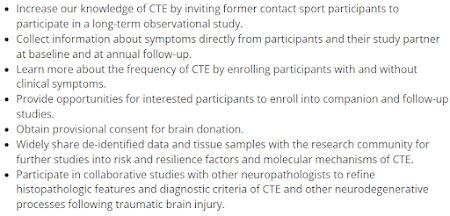I have written about the NFL's response to concussion data as a case study of how to obfuscate data. This has been covered in many places, including in The Atlantic and on PBS.
In my experience, concussions are a prime source of conversation for traditionally college-aged students. Many of them were high school athletes. Fewer are college athletes. Most college students have personally experienced a concussion or loves someone who has.
Now, the University of Pittsburgh is opening the National Sports Brain Bank. This is for athletes, not just football players. Two former Steelers have promised their brains, as have two scientists who played contact sports.
Here is a press release from the University of Pittsburgh. Here is a news report featuring the two Steelers who have promised to donate their brains.
However, as described by Aschwander, we still don't know how many football players have CTE (please read this piece, it is such good stats literacy from Aschwander).
How to use this in your class: Read the FAQs to understand their purpose and methodology.
1. Discuss samples and populations.
CTE discussions usually revolve around football players and people in the military. But the true population here are all people in contact sports or may have experienced a concussion.
2. Sometimes, researchers wish to gather data from people who know you, not just from you.
3. Longitudinal research
This research involves gathering baseline information but also data over time. Finally, the big ask is for the participants' brains to be donated for further study after death.
4. Goals of the research
And HERE is what they want to do, which you can use to talk to your students about consent, bigger sample size, study people with concussions who don't experience CTE, etc.
5. Research happens at universities and is multidisciplinary.




Comments
Post a Comment